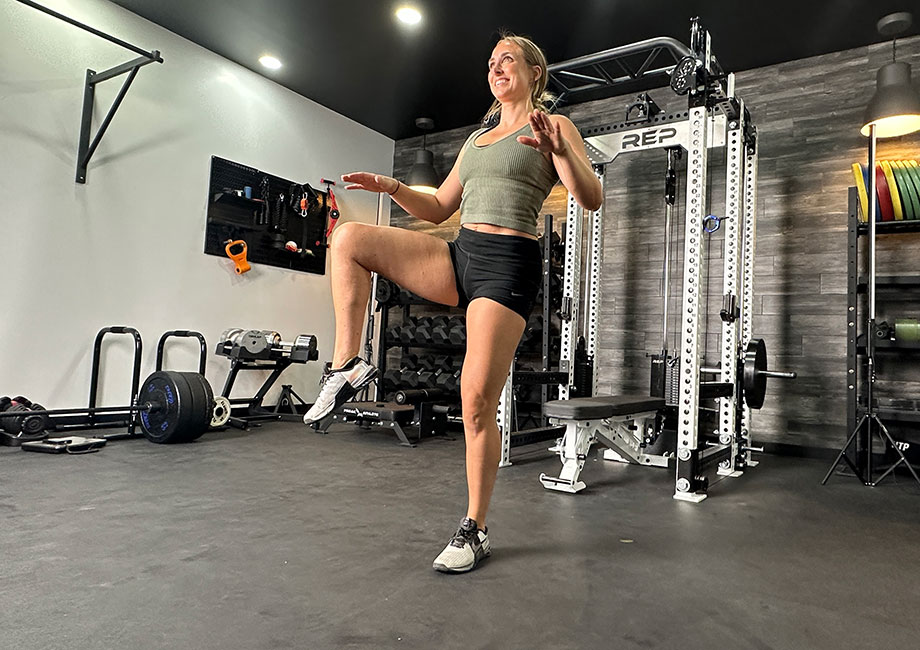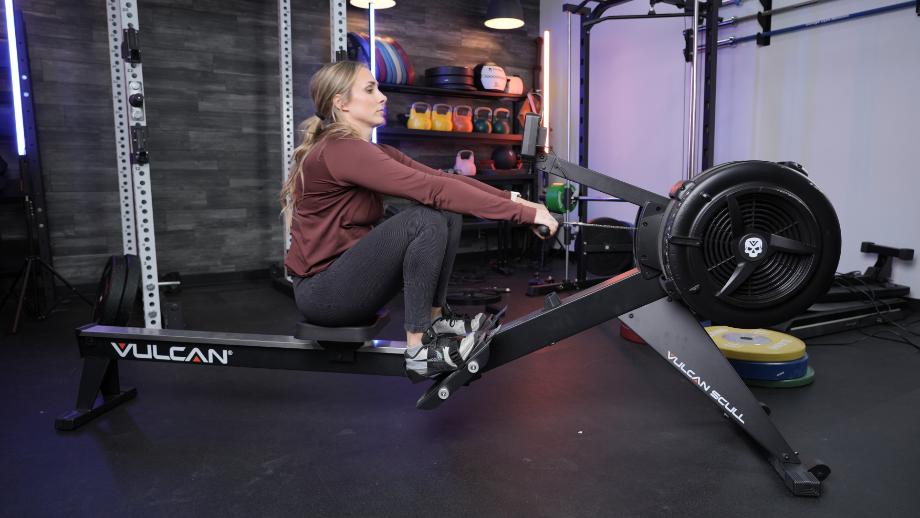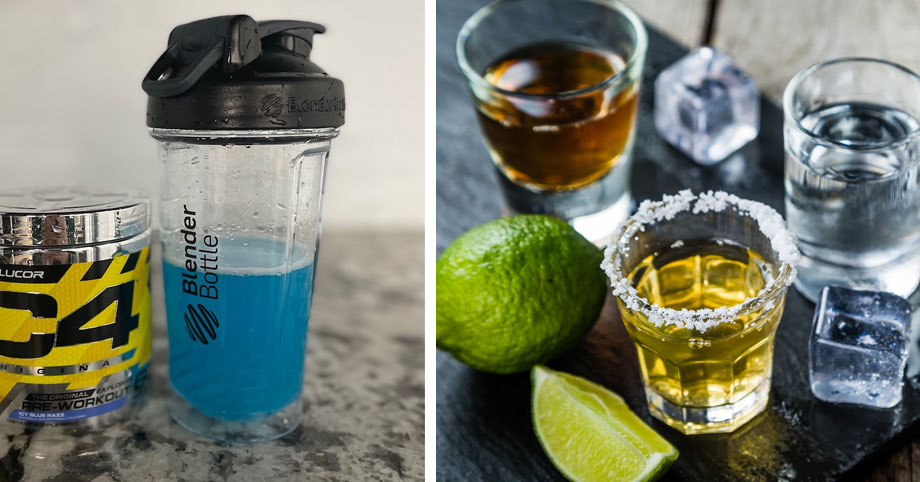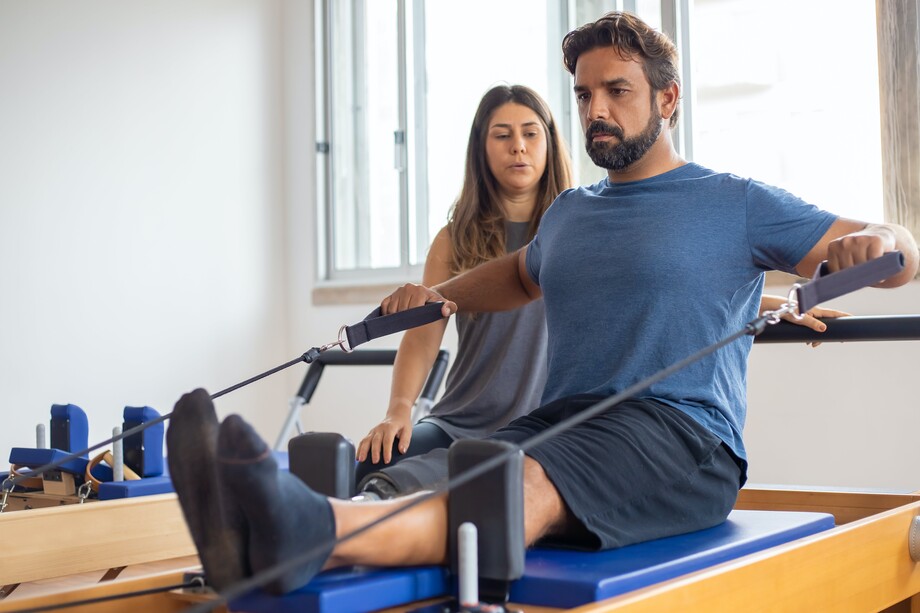Walk into any gym in the world, and you’ll get those hardcore people who are dead set on one thing and one thing only. Nothing will change their mind, no matter what studies or evidence you put before them. “What’s that one thing?” you ask. It’s this: Free weights are the only way to gain muscle, and nothing else will suffice.
RELATED: Smith Machine Vs. Free Weights
Free weights are great, don’t get me wrong, and I regularly use them in my own training and with others as a certified personal trainer (CPT). But they aren’t the only way to build strength and muscle in the gym or at home. You can effectively get results using the best cable machine for your home gym, resistance bands, or, you guessed it, your body weight, too. The latter of these will be the focus for today.
I’ll explain bodyweight workouts and the benefits of doing them. Then, I’ll go through step-by-step how to do the 18 best bodyweight exercises before finishing with a sample at home bodyweight workout for you to try.
Ready to prove those who don’t believe in bodyweight training wrong? I sure am!
What is a Bodyweight Workout?
Simply put, a bodyweight workout is a collection of bodyweight exercises that you perform. Bodyweight exercises don’t use barbells, dumbbells, kettlebells, resistance bands, fixed resistance machines, cable machines, or any other home gym essentials.
The only resistance is the weight of your body. That’s all there is to it.
RELATED: Bodyweight Back Exercises
Bodyweight Vs. Free Weight Exercises
No additional equipment is required for bodyweight exercises, so they can be done from anywhere at any time. “Because you have fewer choices of exercises compared to a gym, you’re more likely to pick exercises that focus on cardio and mobility, as well as strength,” says Kate Meier, certified personal trainer (CPT), USAW-L1, CF-L1, and GGR Head of Content. Bodyweight training may help build a more well-rounded physique compared to solely focusing on lifting heavy weights.
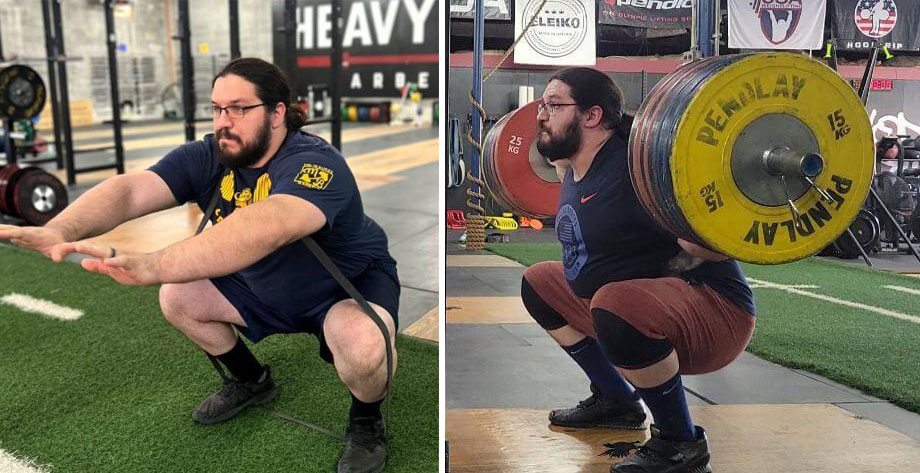
Free weight exercises using dumbbells and barbells often require spendy equipment (check out our guide to the Best Budget Home Gym Equipment) or a gym membership. Form is even more important, and your workout may take significantly longer compared to bodyweight training. With bodyweight training, you’ll get a whole range of exercises to choose from and the ability to isolate every muscle group and progress to your heart’s content.
So, which one is better? It depends. If you’re a beginner and want to train at home for 20 or 30 minutes, you can try an at-home bodyweight workout. If you have more time or want to add variety to your training, head to the gym (or your garage) and lift some free weights. Alternatively, do both. Gym it up when you’re able, and do bodyweight workouts when you’re not. Simple as that.
RELATED: Conditioning Workouts
Benefits of Bodyweight Workouts
If you’re still wondering, “What are the benefits of bodyweight workouts?” Here are the top three:
Can Be Done Anywhere
I’ll be sharing an at-home bodyweight workout with you, but the truth is, the location doesn’t matter. What matters is that you get it done, whether that’s at home, in your hotel room, or even at the park. The best thing about bodyweight training is that all you need is a little bit of space. No more reason not to get a workout in, right?
RELATED: DIY Outdoor Bodyweight Gym
They’re Functional And Versatile
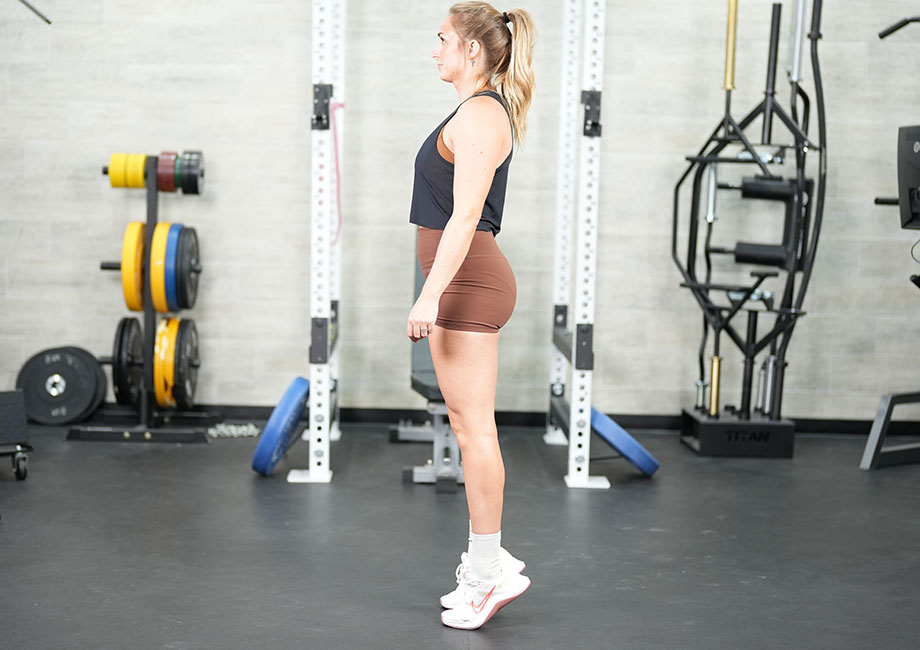
With bodyweight exercises, there are tons of progressions and regressions, making them extremely versatile. You can decrease rest times or increase the number of reps to get a more challenging workout compared to the one before. “Bodyweight exercises are functional because they mimic movements you perform in real life, for example, squats and calf raises,” adds Kate Meier, CPT, USAW-L1, CF-L1.
Work with Various Fitness Goals
Whether your goal is to build muscle or improve your cardiovascular health, there are bodyweight exercises for everyone’s needs. Heck, you might even want to do both—check out our sample bodyweight workout below! And for those limited in time, bodyweight training can still enhance cardiorespiratory fitness1 in inactive adults.
Best Bodyweight Exercises
Now that you know what bodyweight workouts are and their benefits, here are the 18 best bodyweight exercises you can include in your at-home bodyweight workout.
Push-Up
Why we love it: Push-ups can be made easier by putting your knees on the floor or doing them against a wall or a chair. You can also add more difficulty by doing an advanced variation, such as diamond push-ups, pike push-ups, one-handed push-ups, and more.
How to do it:
- Get into the high plank position (also known as the push-up position), with your hands slightly wider than shoulder-width apart.
- Brace your core, squeeze your glutes, and bend your elbows to lower your body towards the floor.
- Once your chest is as close to the floor as possible, stop, then reverse the motion until your arms are straight.
- Continue for the desired number of repetitions.
Muscles worked: Chest, shoulders, triceps, core
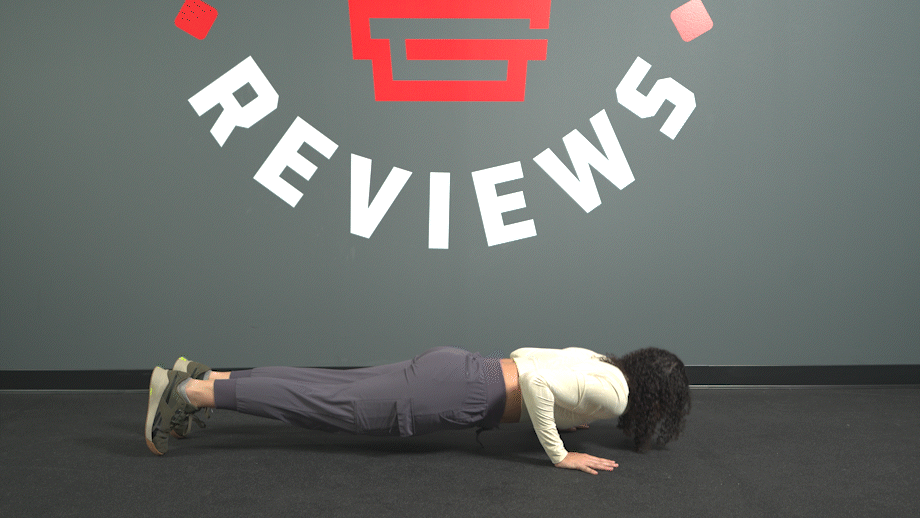
Plank
Why we love it: Planks are an effective exercise for ventral core muscle activation2. “You can hold planks for longer to challenge yourself and build strength in your core,” Kate Meier, CPT, USAW-L1, CF-L1, explains. “Or, you can try side planks, plank shoulder taps, plank jacks, or any other alternative.”
How to do it:
- Place only your forearms and toes on the floor or exercise mat, ensuring the rest of your body is off the ground.
- Squeeze your glutes, tense your core, and make sure there’s a straight line from your head to your toes.
- Hold for as long as possible, or until you’ve reached your desired time.
Muscles worked: Core
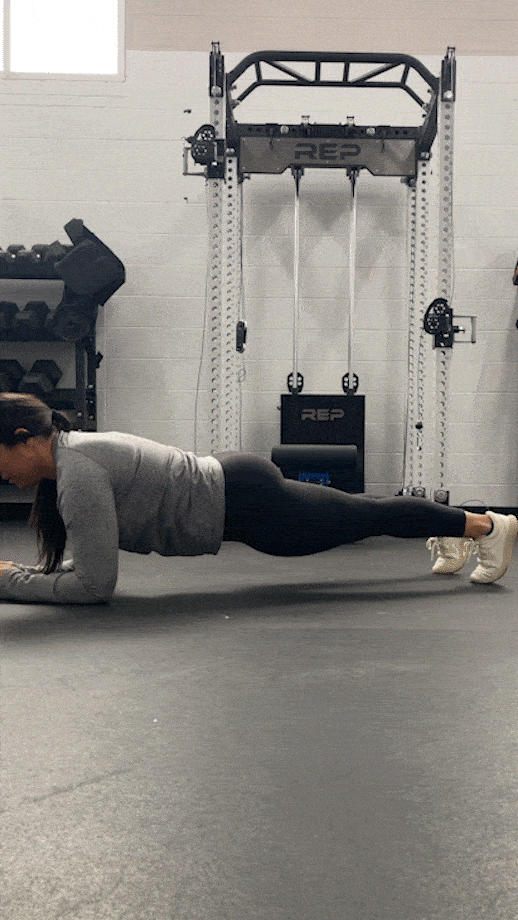
Burpee
Why we love it: The burpees exercise is a great way to improve your cardiovascular endurance without equipment. Not only that, but you’ll also build full-body strength because you’ll be getting onto the ground and back up.
How to do it:
- Stand tall with your arms down by your sides, your head neutral, and your feet hip-width apart.
- Hinge at the hips to bend forward, and place your hands on the floor. At the same time, hop your feet backward to get into the high plank position.
- Drop down to the floor, touching your quads and chest to the ground.
- Reverse the motion by pushing your body back to the high plank position, bringing your left foot and right foot forward, and lifting your arms up.
- To finish the movement, jump up, raising your arms above your head.
- Land on your feet and bring your arms back to your sides to get into the starting position.
- Keep going for reps.
Muscles worked: Quads, hamstrings, glutes, calves, core, chest, shoulders, triceps
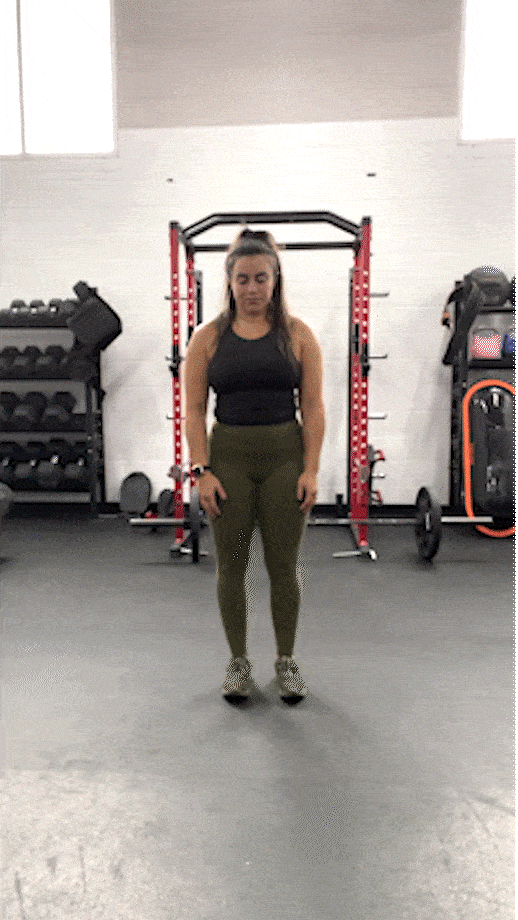
Bodyweight Squat
Why we love it: You squat many times throughout the day, like when you sit down on a chair, for example. Performing bodyweight squats may lead to better muscle movement in the lower body. It’s important to squat at least parallel to improve strength and functional performance3.
How to do it:
- Stand upright, positioning your feet hip-width apart, toes pointing slightly outwards, and head neutral.
- Brace your core and extend your arms in front of your body.
- Perform a squat until your quads are parallel to the floor. Pause.
- Drive your heels into the ground and return to the upright position.
- Squat for repetitions.
Muscles worked: Quadriceps, hamstrings, glutes, calves, hip flexors, core
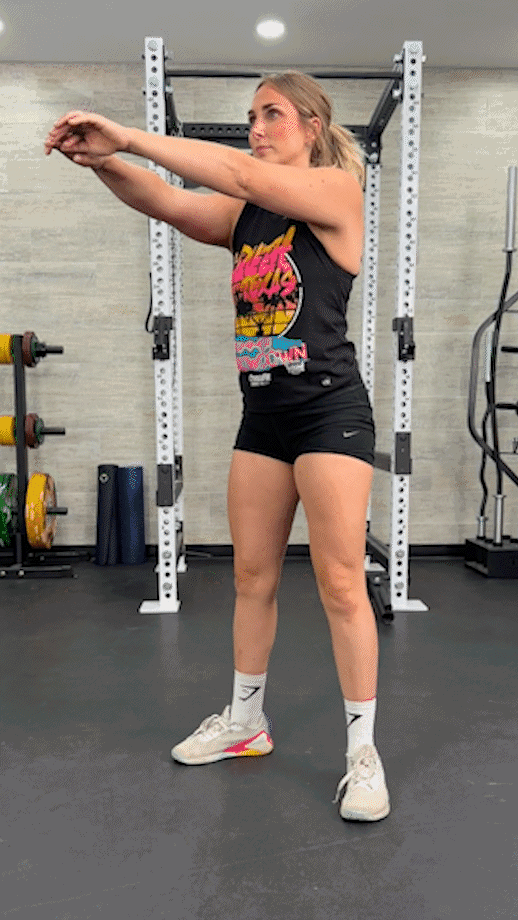
Glute Bridge
Why we love it: Kate says, “If you’re looking to improve hip mobility and flexibility, bridges are a great exercise to add to your workout routine.” For those with desk jobs, your glutes can weaken, and your hip flexor muscles can become tight over time. Bridges may help you overcome this. If the movement feels too easy, try single-leg glute bridges instead.
How to do it:
- Lie down on an exercise mat, facing the ceiling. Place your feet flat on the floor so there’s a bend in your knees.
- Drive your feet into the ground and lift your butt off the floor.
- At the top, squeeze your glutes and hold. Then, lower yourself to the floor.
- Continue for reps.
Muscles worked: Glutes, hamstrings, core
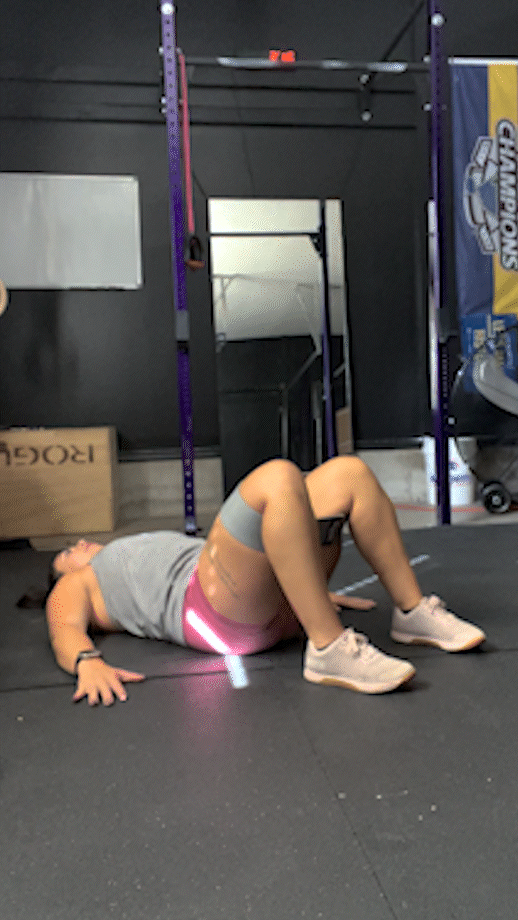
Step-Up
Why we love it: Step-ups are a unilateral exercise and a great addition to your home workout as they can help fix muscular imbalances. I also like that it’s easier on the lower back because your spine is under less pressure during the movement compared to other exercises.
How to do it:
- Find a piece of equipment to use. Examples include a chair, stairs, a plyo box, or even your couch. Stand next to it with your feet shoulder-width apart.
- Place your left foot onto the equipment so there’s a 90-degree angle in your left knee.
- Lift your right foot off the floor. While transferring your weight to your left leg, step your right foot onto the stepper. Pause here.
- Go down to the standing position with your left foot first, then your right foot second.
- Repeat, but this time, lead with your right leg (so your right knee is at a 90-degree angle).
- Step for repetitions, alternating sides each time.
Muscles worked: Quads, hamstrings, glutes, core
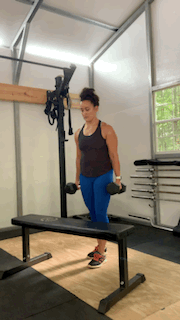
Squat Jump
Why we love it: Squat jumps are a more advanced version of bodyweight squats and get your heart rate up quickly. Explosive exercises such as this one are known as plyometric exercises. Benefits include improved coordination, more power and strength, and increased training focus.
How to do it:
- Get into the bodyweight squat position (which you saw above!).
- Squat down as deep as you can, but this time, drive your heels into the ground to help you jump up off the ground. Go as high as you can.
- Softly land, then adjust your body to get back into the squat position.
- Continue for repetitions.
Muscles worked: Quads, hamstrings, glutes, calves, hip flexors, core
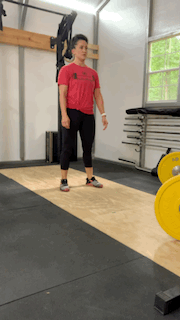
Inchworm
Why we love it: Inchworms are a full-body exercise because they work multiple muscle groups. “They’re kind of like a burpee but slower,” says Kate. If you have tight hamstrings, inchworms may help because you’re opening up the whole posterior chain.
How to do it:
- Stand tall with your feet shoulder-width apart and your arms by your sides.
- Bend at the hips and knees, placing your palms on the ground. You’ll want them to be as close to your feet as possible.
- Brace your core, and walk forward with your hands until you’re in the high plank position. When you get there, do a push-up.
- Reverse the motion by walking your hands backward to the original position. Stand up.
- Keep going for reps.
Muscles worked: Quads, hamstrings, glutes, chest, back, shoulders, triceps, core
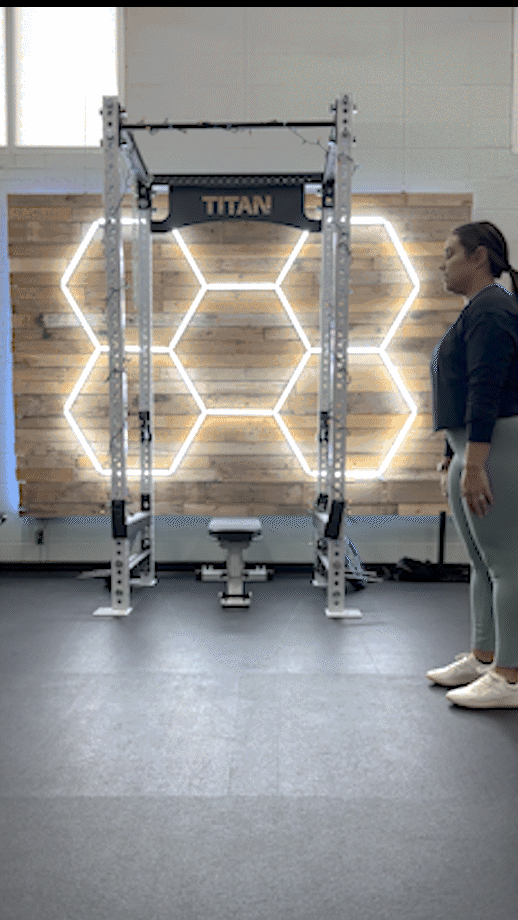
Lunge
Why we love it: The lunges exercise is one of my favorite bodyweight moves because they can activate the muscles in your lower body. If losing body fat is your goal, you have a better fat-loss potential with lunges, because you’re doing double the reps (one rep on each side). You’ll improve your balance too.
How to do it:
- Stand up with your feet hip-width apart and toes pointing forward. Place your hands on your hips.
- With your left foot, lunge forward. Lower your right knee toward the floor until your left quad is parallel to the floor. Hold for a moment.
- Drive through your left heel to return to the original position.
- Repeat on the opposite side, with your right foot forward.
- Lunge for the desired number of reps, alternating legs each time.
Muscles worked: Hamstrings, glutes, quads, core
RELATED: What Muscles Do Lunges Work?
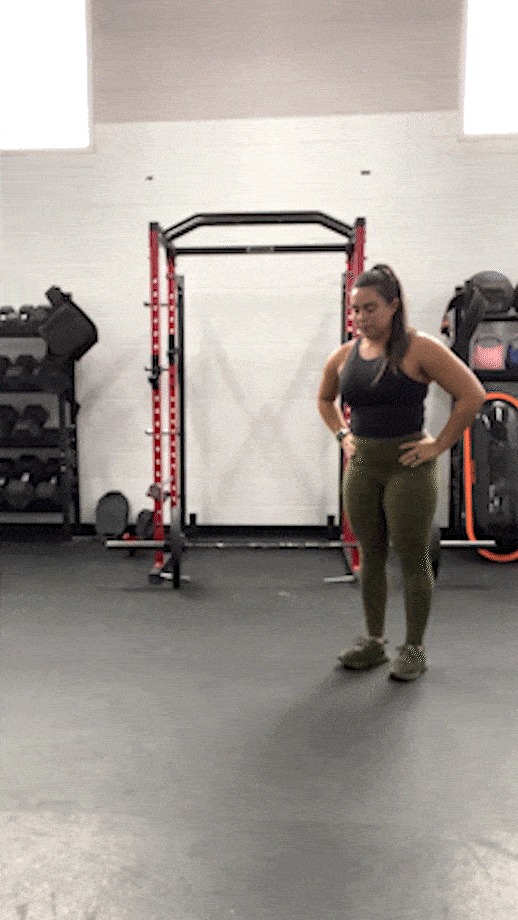
Jumping Jacks
Why we love it: “Jumping jacks improve cardiovascular fitness and increase coordination,” explains Kate. “As a personal trainer, my clients seem to find them fun to do, too, which is always a bonus!”
How to do it:
- Stand upright with your arms by your sides and your feet shoulder-width apart.
- Jump both feet to the sides. At the same time, lift both of your arms above your head until they’re close to touching each other. Keep your head neutral.
- Return to the starting position and repeat for reps.
Muscles worked: Quads, hamstrings, glutes, shoulders, chest, back, arms, core (yes, literally the whole body!)
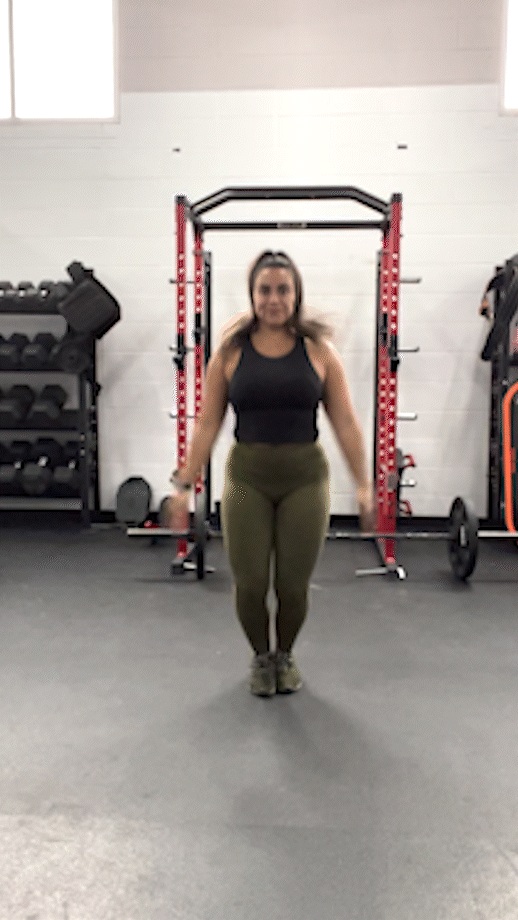
Mountain Climbers
Why we love it: Mountain climbers predominantly work the abdominal muscles (especially the obliques), but also hit muscles throughout your entire body. “Doing them quicker helps to raise your heart rate and get the blood pumping to your muscles,” Kate adds.
How to do it:
- Get into the high plank position. Your hands should be positioned slightly wider than shoulder-width apart.
- Brace your core, squeeze your glutes, then bring your left knee towards your left elbow.
- Return your left foot to the floor. Repeat, but this time, bring your right knee towards your right elbow.
- Alternate sides until you’ve reached your rep goal.
Muscles worked: Core, shoulders, chest, triceps, legs
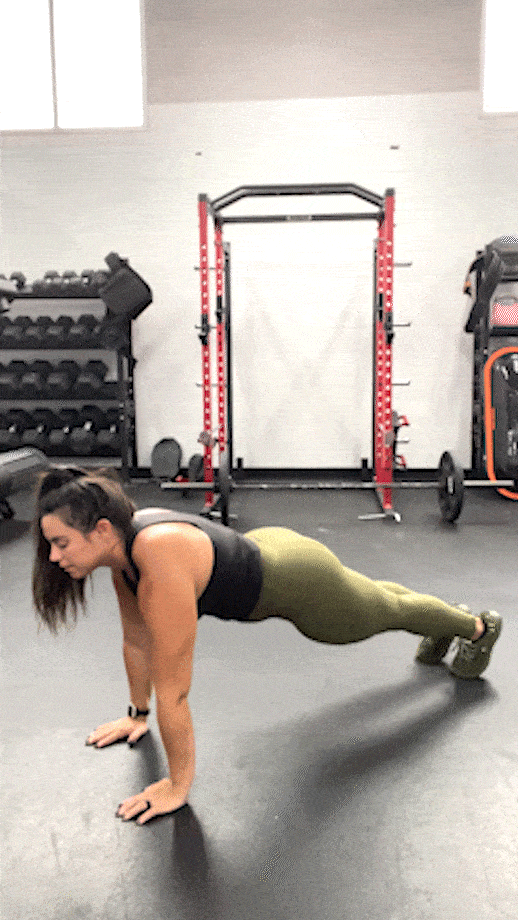
Superman
Why we love it: A 2018 study in the Journal of Exercise Rehabilitation4 shows that regularly performing the Superman exercise may help to reduce pain in the lower back. Stronger glutes can help you walk and run better, as well as improve your lifts in the gym. If you spend a lot of time at your desk, Supermans may help give you better posture, too.
How to do it:
- Lie on the floor facing downward, with your legs and arms extended.
- Squeeze the muscles at the back of your body. Then, lift your arms and legs off the floor.
- Hold for a few seconds, then drop your legs and arms down.
- Continue for the desired number of repetitions.
Muscles worked: Lower back, hamstrings, glutes, abdominals
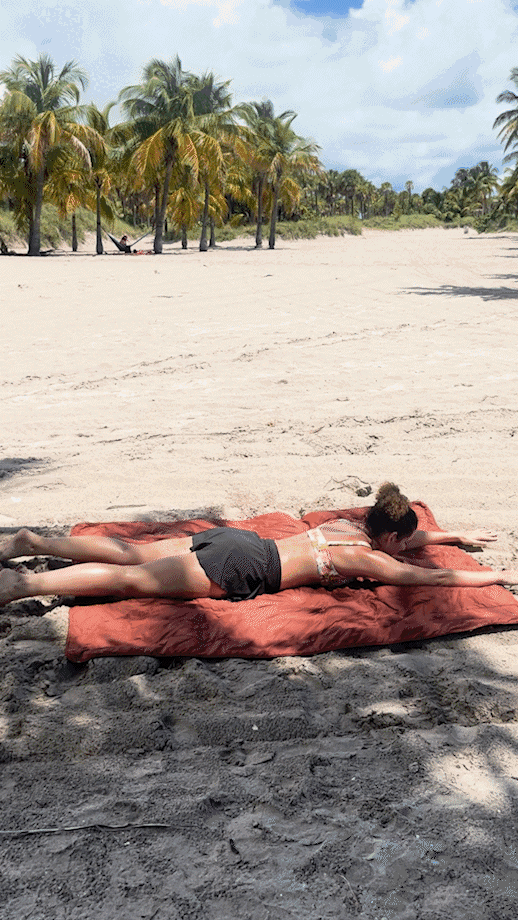
Wall Slide
Why we love it: When you place objects above your head, you use your upper body, predominantly your shoulders and upper back. Wall slides help increase strength and mobility in these muscles. They can also help reduce pain and improve scapular alignment5, especially in subjects with scapular downward rotation.
How to do it:
- Stand against a wall, facing away. You’ll want the back of your head, upper back, and glutes touching it.
- Place your arms against the wall at a 90-degree angle.
- To start the movement, lift both arms towards the ceiling. It’s important to drive your glutes and core into the wall whilst doing this.
- When you can’t raise your arms any further, pause. Then, bring them down to the starting position.
- Repeat for reps.
Muscles worked: Upper back, shoulders, serratus anterior
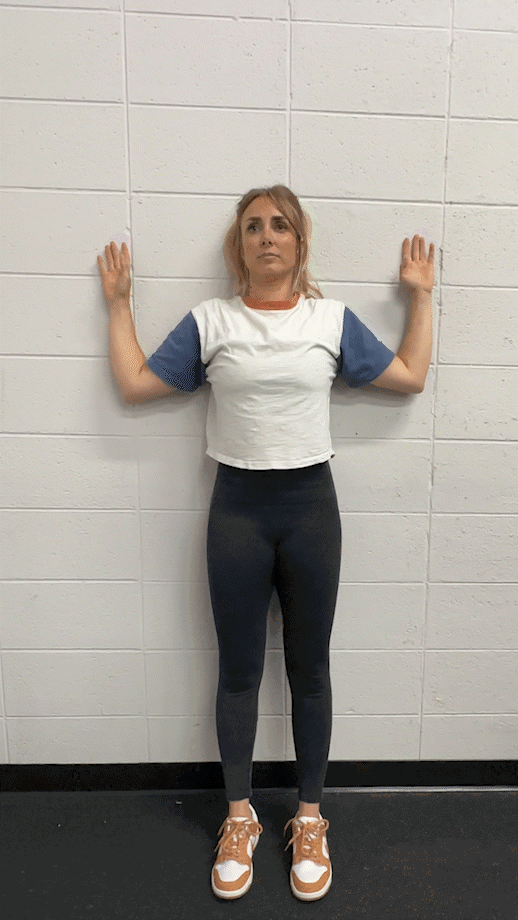
Dips
Why we love it: There aren’t many at home bodyweight exercises that are great for muscle-building of the triceps, but the triceps dips exercise is one of them. Keep doing them, and bigger arms could be the end result—and let’s be honest, who doesn’t want bigger arms?
How to do it:
- Place both hands on the edge of a stable surface, with your fingers pointing forward.
- Walk your feet out until the weight is on your arms. Adjust your legs so they’re either straight or bent at a 90-degree angle (either works!).
- Brace your core, then bend at the elbows to lower your body toward the floor.
- Hold once you can’t lower any further, then push through your hands to return to the top position.
- Dip for repetitions.
Muscles worked: Triceps, chest, shoulders, back
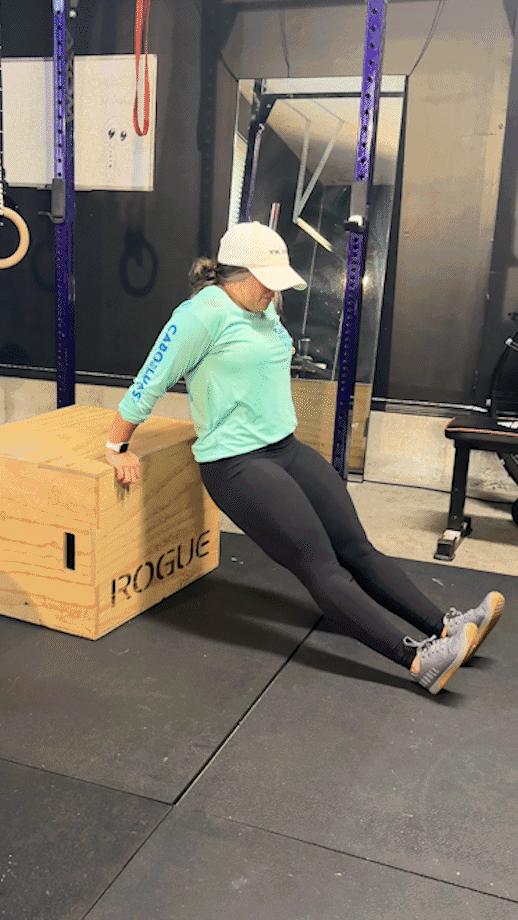
Calf Raise
Why we love it: Kate says, “Calf raises are a great way to build strength in the calves and stability in the ankles, using your own bodyweight only.” If you find the below too easy, try some single-leg calf raises instead.
How to do it:
- Stand tall with your feet shoulder-width apart and arms by your sides.
- Lift your heels off the floor until you’re on your tiptoes.
- Hold, then slowly lower yourself down.
- Raise for reps.
Muscles worked: Calves
RELATED: Calf Exercises
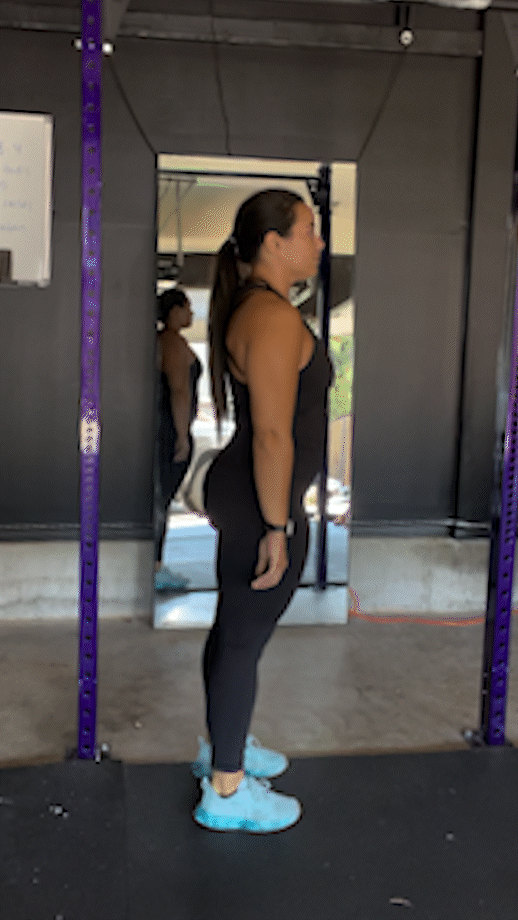
Curtsy Lunge
Why we love it: The curtsy lunge is a unilateral exercise, so it helps fix muscular imbalances. To get them right, you’ll need to use balance and coordination. Also, I like the fact that they work your hips, so if you have tight hips, they’re definitely one to try!
How to do it:
- Stand up with your feet shoulder-width apart.
- Using your left foot first, take a big step behind your right foot.
- At the same time, lower your left knee to the ground until the right quad is parallel to the floor. Here, you’ll be in a curtsy pose.
- Push through the right heel to return to the upright position. Repeat, but this time, step your right foot back.
- Continue alternating sides for repetitions.
Muscles worked: Quadriceps, hamstrings, glutes, hips
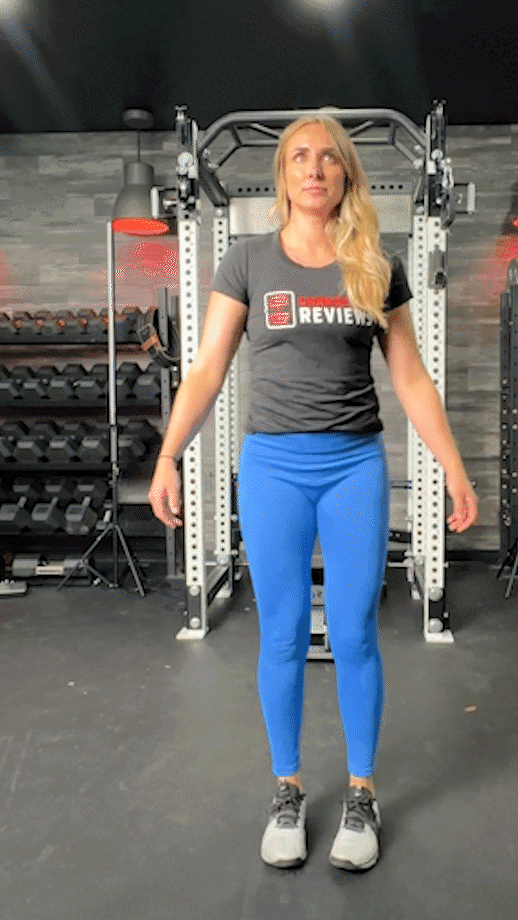
Crunches
Why we love it: Well, the crunches exercise has become one of the most popular core exercises for a reason, so they’ve got to be doing something right, don’t they? There are tons of variations, and they increase strength and stability in the core.
How to do it:
- Lie down on an exercise mat, facing the ceiling. You’ll want to plant your feet firmly on the ground, so your knees are bent at a 90-degree angle.
- Take both hands and clasp them behind your head.
- Tense your core, then lift your head and upper back off the ground.
- Pause, then lower your upper body down.
- Keep going for repetitions.
Muscles worked: Rectus abdominis
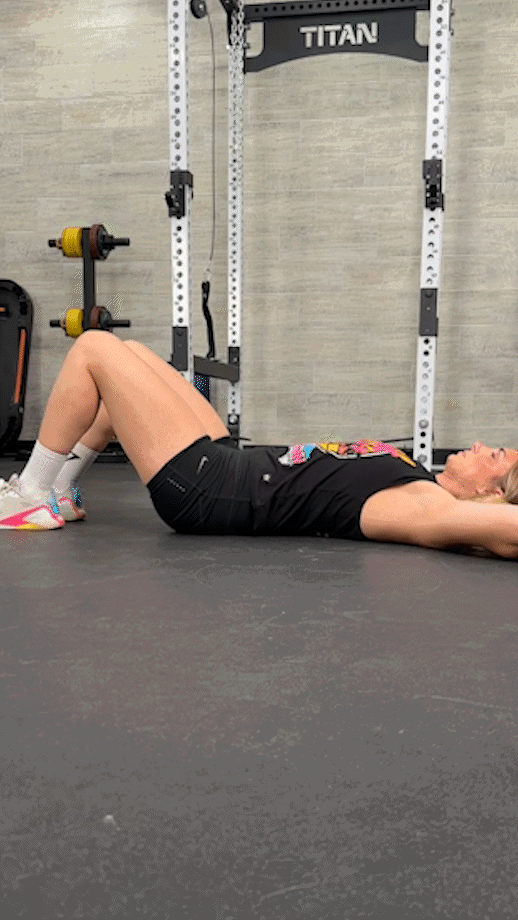
High Knees
Why we love it: “If you think you need a treadmill or another cardiovascular piece of gym equipment to get you sweating, think again,” Kate says. High knees may not build as much strength as some other exercises on this list, but they sure do burn calories.
How to do it:
- Stand tall with your feet hip-width apart, and your arms out in front of you.
- Ensuring that your chest is up and your head is neutral, lift your left knee up toward your left hand.
- Drop your left leg to the floor, then repeat with your right knee. It’s important to choose the right pace that works for you.
- Alternate for repetitions or until you’ve hit your time goal.
Muscles worked: Quads, glutes, hamstrings, calves
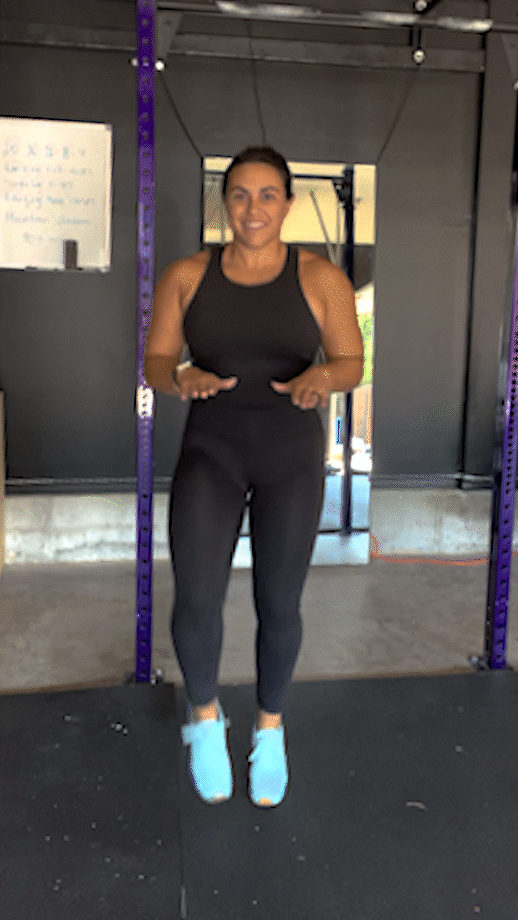
Sample Bodyweight Workout
Okay, so you know how to do the best bodyweight exercises at home. But how can you program these into a full workout? Don’t worry, I—with an assist from Kate Meier, CPT, USAW-L1, CF-L1, and GGR Head of Content)—have got you covered. Here’s a sample workout that has three components: a warm-up, a strength component, and a cardio component:
Warm-Up
- Bodyweight Squat: 10 reps
- Glute Bridge: 15 reps
- Calf Raise: 15 reps
- Wall Slide: 12 reps
- Superman: 12 reps
- Inchworm: 10 reps
RELATED: Best Warm-Up Exercises
Strength
It’s up to you how you want to do this. You could start with push-ups, do two or three sets with a rest in between, and then move on to squat jumps. Or, you could do it in a circuit format with a short rest in between each exercise, repeating the circuit one, two, or three times:
- Push-Up: 10 reps
- Squat Jump: 12 reps
- Plank: Hold for 60 seconds
- Steps-Up: 8 reps on each leg
- Dip: 10 reps
- Lunge (or Curtsy Lunge): 8 reps on each leg
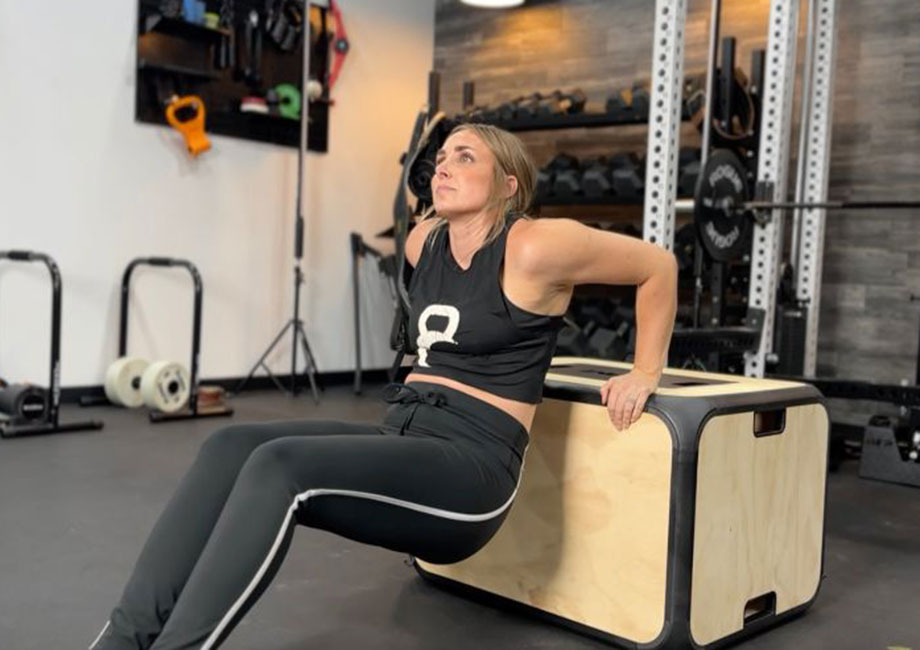
Cardio
Do the following five exercises in a circuit format, doing as many reps as possible at high intensity for 40 seconds. Rest for 20 seconds, before moving on to the next exercise. Repeat one, two, or three times altogether:
- Burpees
- High Knees
- Mountain Climbers
- Jumping Jacks
- Crunches
At Home Bodyweight Workout: Final Thoughts
Although it’s a common belief that free weights or workout machines are the only way to build muscle, that belief simply isn’t true. You can build muscle, increase strength, and improve your cardio by doing at-home bodyweight workouts. They can be done from anywhere, regardless of your fitness goals. Give our sample bodyweight workout a go, and you’ll see why we love them!
At Home Bodyweight Workout: FAQs
Can you really build muscle with bodyweight exercises?
Yes, you can really build muscle with bodyweight exercises, especially if you’re new to strength training. Bodyweight exercises are a form of resistance training; they just use your body weight rather than free weights or machines. The same rules of muscle building apply—increase the demands on your body’s musculoskeletal system by using progressive overload.
Is it OK to do bodyweight exercises everyday?
Personally, I (a certified personal trainer) wouldn’t recommend doing bodyweight exercises every day. When you do them, you’re breaking down muscle fibers. As is the case with free weights, your muscles need time to recover before you can work them again. If you work them daily, you could get injured, and you definitely don’t want that to happen! Take rest days from time to time.
What are the disadvantages of bodyweight exercises?
There are some disadvantages of bodyweight exercises. The main one is that they won’t always give you the gains you’re looking for in terms of increasing strength and size. With a bench press, for example, you can load the weight on the bar for as long as you please, but the same doesn’t apply to bodyweight exercises. You’ll need to add more resistance at some point.
It’s also difficult to isolate certain muscle groups with bodyweight exercises. Kate Meier, CPT, USAW-L1, CF-L1, and GGR Head of Content, says, “In the gym, there are pieces of kit designed to target a specific muscle, but the same doesn’t always apply to bodyweight exercises.” It’s likely that you won’t hit every muscle group during your bodyweight training.
Can you get toned without weights?
In terms of getting toned, you’re likely referring to adding muscle and losing body fat. If this is the case, then yes, you can get toned without weights. Doing any form of resistance training, including bodyweight workouts, can help to increase muscle. What you eat is key, however, and it’s likely that you’ll need to be in a calorie deficit to achieve that toned look.
References
- Archila LR, Bostad W, Joyner MJ, Gibala MJ. Simple Bodyweight Training Improves Cardiorespiratory Fitness with Minimal Time Commitment: A Contemporary Application of the 5BX Approach. Int J Exerc Sci. 2021 Apr 1;14(3):93-100. PMID: 34055156; PMCID: PMC8136567.
- Zahiri A, Alizadeh S, Daneshjoo A, Pike N, Konrad A, Behm DG. Core Muscle Activation With Foam Rolling and Static Planks. Front Physiol. 2022 Mar 8;13:852094. doi: 10.3389/fphys.2022.852094. PMID: 35370773; PMCID: PMC8964357.
- Pallarés JG, Cava AM, Courel-Ibáñez J, González-Badillo JJ, Morán-Navarro R. Full squat produces greater neuromuscular and functional adaptations and lower pain than partial squats after prolonged resistance training. Eur J Sport Sci. 2020 Feb;20(1):115-124. doi: 10.1080/17461391.2019.1612952. Epub 2019 May 15. PMID: 31092132.
- Hwang YI, Park DJ. Comparison of lumbar multifidus thickness and perceived exertion during graded superman exercises with or without an abdominal drawing-in maneuver in young adults. J Exerc Rehabil. 2018 Aug 24;14(4):628-632. doi: 10.12965/jer.1836296.148. PMID: 30276184; PMCID: PMC6165989.
- Kim TH, Lim JY. The effects of wall slide and sling slide exercises on scapular alignment and pain in subjects with scapular downward rotation. J Phys Ther Sci. 2016 Sep;28(9):2666-2669. doi: 10.1589/jpts.28.2666. Epub 2016 Sep 29. PMID: 27799716; PMCID: PMC5080198.


